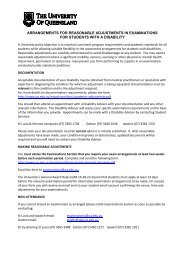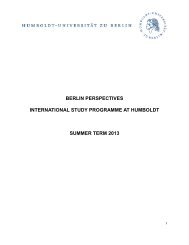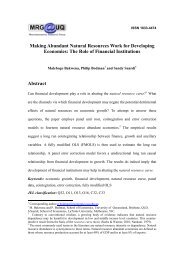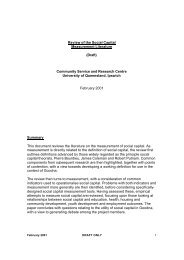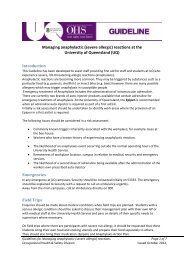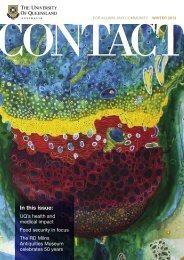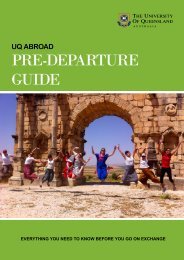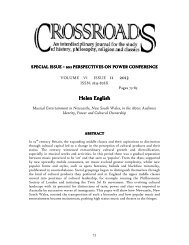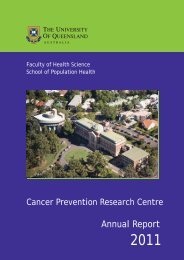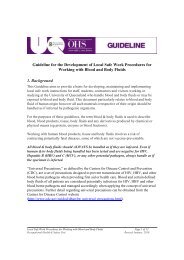Memmott, Paul and Chambers, Catherine - University of Queensland
Memmott, Paul and Chambers, Catherine - University of Queensland
Memmott, Paul and Chambers, Catherine - University of Queensland
Create successful ePaper yourself
Turn your PDF publications into a flip-book with our unique Google optimized e-Paper software.
FINDING PATHWAYS OUT OF HOMELESSNESSAll <strong>of</strong> the interviewees had been eager to find a solution to their homeless situation <strong>and</strong>none identified as voluntarily dwelling in public places. However, some <strong>of</strong> therespondents said that they would still choose to spend time socialising in the public placedwelling group with whom they affiliate, even if they were to obtain stableaccommodation.The interview data were generally less revealing about potential pathways out <strong>of</strong>homelessness. Respondents were not as forthcoming or knowledgeable about how others<strong>of</strong> their acquaintance had accessed <strong>and</strong>/or maintained stable housing. And the researchteam did not have the capacity to investigate whether the examples provided had trulyremained in secure accommodation. The majority <strong>of</strong> interviewees that did respond to thisquestion believed that people had received help through the NSW Department <strong>of</strong> Housingbut provided no further details. However certain conclusions can be drawn from theinterviews <strong>and</strong> the pathways into homelessness that were identified. The case studiesregarding young people revealed the importance <strong>of</strong> intervening early in situations wheremental illness, unstable custodial arrangements or family violence are factors. These areserious concerns considering the level at which these problems are occurring in Aboriginalcommunities throughout Australia. With regard to mental illness <strong>and</strong> the effects <strong>of</strong> longtermalcohol <strong>and</strong> drug abuse, the previous discussion suggests that intensive casemanagement <strong>and</strong> ongoing support is vital to keeping people affected by these problems instable accommodation. It also reveals the social cost inherent in having people spend longperiods <strong>of</strong> time as public place dwellers. A strategy to divert people from this coursewould be highly beneficial to the individuals themselves, but would also reduce the needto outlay lifelong support resources. A potential barrier to people moving out <strong>of</strong>homelessness characterised by substance abuse was created when people had to wait forrehabilitation accommodation after undergoing a detoxification program. Thisdemonstrates that gaps between the programmes <strong>of</strong> different service providers can have asimple but powerful effect.Another factor, not discussed elsewhere in the literature, that was found to haveinfluenced the homeless state <strong>of</strong> both the male Aboriginal researcher <strong>and</strong> a prominentlocal Aboriginal figure was the involvement <strong>of</strong> charismatic, comm<strong>and</strong>ing religiousfigures. Priests who provided not only practical support, but also spiritual <strong>and</strong> moralguidance helped both men out <strong>of</strong> homelessness. These mentors <strong>and</strong> the religions theychampioned served as powerful influences in these men's lives. In some way such priestsmay have modelled some <strong>of</strong> the effective aspects <strong>of</strong> intensive case management, such asclose attention to people's lives <strong>and</strong> making an effort to underst<strong>and</strong> the things that havebrought them into their current situation. This provides a channel <strong>and</strong> a focus that may bemissing from a secular life.SUMMARY OF IMPACTS OF EXISTING SERVICESThe research team discovered that Aboriginal homeless people did not use to a greatextent the mainstream accommodation services in inner-city Sydney, such as those run bythe major charitable organisations. They accessed day services such as health clinics <strong>and</strong>meals provision, <strong>and</strong> to an extent used overnight accommodation facilities, but they didnot participate in their longer-term accommodation <strong>and</strong> rehabilitation services orprograms.The field researchers found a number <strong>of</strong> instances where the practices <strong>of</strong> governmentdepartments had formed barriers to people exiting their homeless situations. For example,Homelessness Amongst Aboriginal People in Inner Sydney Page 8


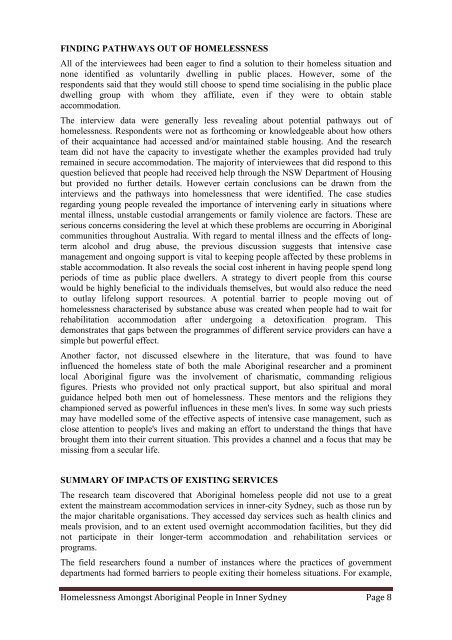

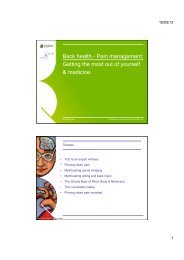
![Recycling [ PDF, 62KB ] - University of Queensland](https://img.yumpu.com/51805185/1/184x260/recycling-pdf-62kb-university-of-queensland.jpg?quality=85)
